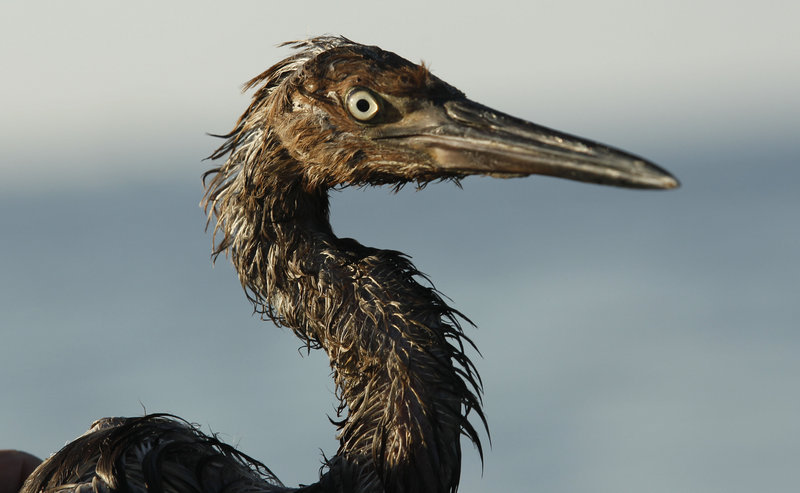ON BARATARIA BAY, La. – While oil companies have spent billions of dollars to drill deeper and farther out to sea, relatively little money and research have gone into finding new, improved ways to respond to oil spills in deepsea conditions like those in the Gulf of Mexico.
Experts say the massive Gulf spill has exposed a failure by the industry and the federal government to commit adequate resources to oil cleanup and response technology.
“Why they didn’t start working on it after the (Ixtoc 1) Mexican spill in 1979 is beyond me,” said Gerald Graham, president of Worldocean Consulting, an oil spill prevention and response planning firm in British Columbia. “Now they’re trying to catch up.”
Only a fraction of the estimated 69 million to 131.5 million gallons of oil that have spewed into the Gulf have been recovered. About 10 million gallons of oil have been burned off, and 25 million gallons of oil-water mix have been mopped up.
The mainstays of the two-month-long cleanup effort are oil booms, mechanical skimmers and oil dispersants — the same tools used to fight the 1989 Exxon Valdez spill in Alaska.
Improvements to these methods have been incremental and few new ones have been developed, critics say, because oil companies have no financial incentive.
“The technology rapidly advanced for drilling, because there was money to be made,” said Tim Robertson, general manager of Nuka Research & Planning, which specializes in oil spill response planning, and who worked on Seldovia, Alaska’s response during the Exxon spill. “There was nothing similar that applies to oil spill recovery.”
Five companies — Shell Oil, ExxonMobil, ConocoPhillips, Chevron Corp., BP America — together spent about $33.8 billion to explore for new oil and gas in the past three years, according to answers the companies provided this month to a House Energy & Commerce subcommittee.
But their spending on research for safety, accident prevention and spill response is “paltry” by comparison, said Rep. Edward Markey, D-Mass., who chairs the subcommittee and introduced a bill Friday that would redirect $50 million per year in oil and gas royalty payments for research into new spill response technology.
In answers to Congress, most of the companies said they could not segregate costs for the safety- and spill-related research.
For example, ConocoPhillips said it spent $1.3 million over three years on research on safer drilling technologies, but it did not specify how much it spends on accident prevention and spill-related research.
ExxonMobil said it spends $50 million a year on oil spill response, drilling and deep-water development research activities. The company says it has maintained an internal spill research program for 40 years.
BP said the company spent $29 million over three years on safer drilling operations research. But spokesman Robert Wine said BP does not research oil spill cleanup technology. Instead, he said BP supports oil spill response organizations, such as the nonprofit Marine Spill Response Corp.
MSRC’s overall spending was $88 million in 2008, the most recent year for which its IRS filing was available. But it has no budget for research, MSRC spokeswoman Judith Roos told USA Today. Roos did not respond to calls and e-mails from The Associated Press.
The oil and gas industry now is taking steps to explore new technology. And BP has pledged $500 million for research efforts.
For its part, the federal government has spent relatively little to advance cleanup technology for spills.
Congress appropriated only about one-sixth of the $30 million in research grants to universities authorized under the Oil Pollution Act of 1990 after the Exxon Valdez, according to the Coastal Response Research Center.
BP recently ordered 32 centrifuge devices made by a company co-founded by Hollywood actor Kevin Costner, who had invested about $24 million in the project. The company says the largest of the devices can process about 210,000 gallons a day, separating gunk from water.
Deployed on barges, the centrifuges are intended to help skimmers work more efficiently by letting them unload the oil and water mix and cleaning it at sea instead of returning to port each time the tank is full.
Advances in drilling technology have enabled a boom in exploration and drilling in deep waters, where lower temperatures and higher pressures require sophisticated equipment.
“We’ve pushed the envelope more and more on offshore drilling in deep waters,” said Nancy Kinner, co-director of the Coastal Response Research Center, a partnership between the University of New Hampshire and the National Oceanic and Atmospheric Administration.
Yet, she said, not much is known about how to collect oil from deep sea spills or how chemical dispersants used to break up oil behave at such depths.
Copy the Story Link
Send questions/comments to the editors.



Success. Please wait for the page to reload. If the page does not reload within 5 seconds, please refresh the page.
Enter your email and password to access comments.
Hi, to comment on stories you must . This profile is in addition to your subscription and website login.
Already have a commenting profile? .
Invalid username/password.
Please check your email to confirm and complete your registration.
Only subscribers are eligible to post comments. Please subscribe or login first for digital access. Here’s why.
Use the form below to reset your password. When you've submitted your account email, we will send an email with a reset code.